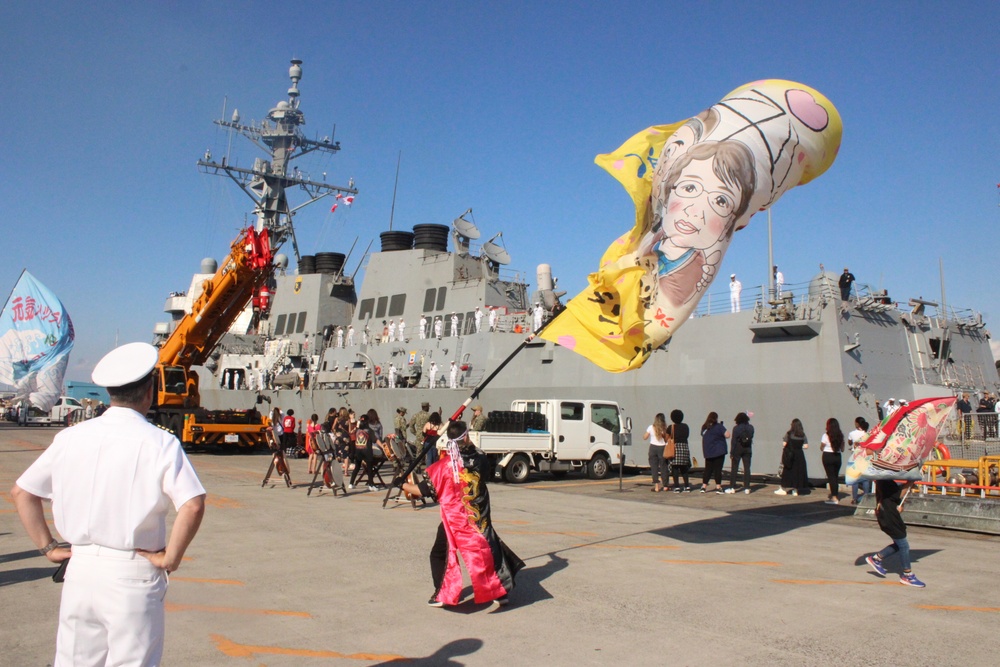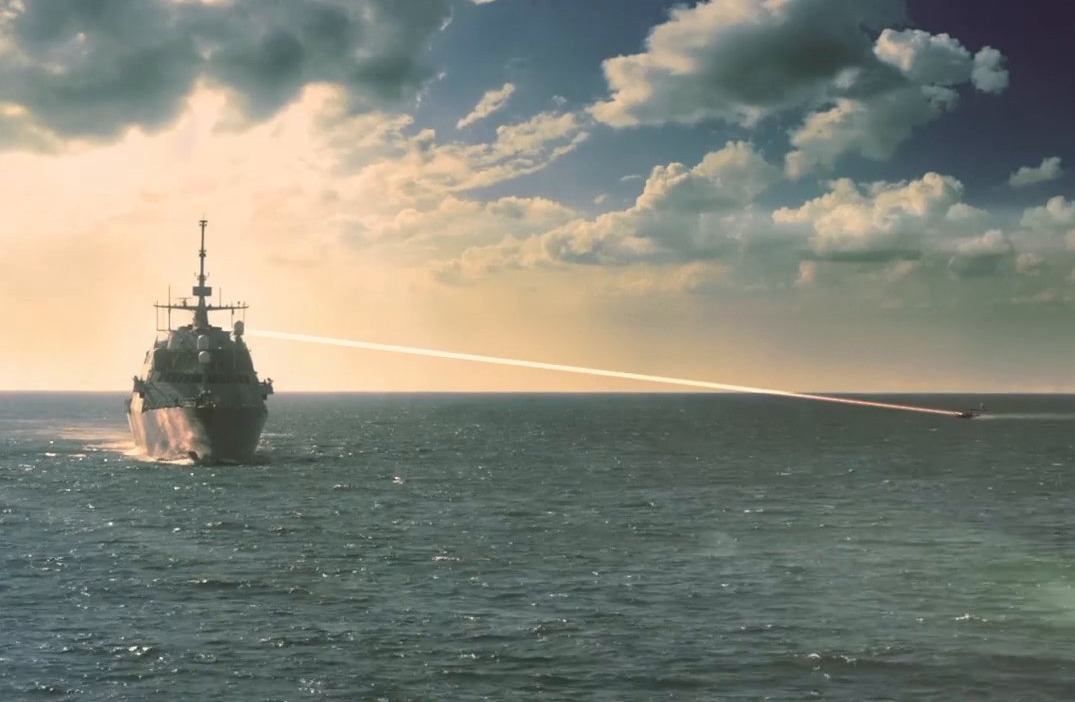Armed With ‘Cutting Edge’ HELIOS Laser Weapon, USS Guided-Missile Destroyer ‘Preble’ Arrives In Japan

The Arleigh Burke-class guided-missile destroyer USS Preble, equipped with the cutting-edge Helios laser weapon system, arrived at its forward-deployed location in Yokosuka, Japan, on October 12.
As part of Destroyer Squadron (DESRON) 15, the largest destroyer squadron in the US Navy and the principal surface force of the US 7th Fleet, the USS Preble joins an elite group tasked with ensuring maritime security in the Indo-Pacific region.
The arrival was greeted with enthusiasm as sailors in dress whites manned the rails while the ship pulled into Tokyo Bay, becoming the tenth destroyer assigned to the squadron.
“We are thrilled to have Preble join the team in the Western Pacific,” said Capt. Justin Harts, Commander, Destroyer Squadron 15.
“Her arrival is a welcome addition to the DESRON 15 family, and her advanced capabilities add unique value. I am excited to get Preble underway with our Allies and partners to see what she can do,” Harts added.
AfriPrime App link: FREE to download...
https://www.amazon.com/Africircle-AfriPrime/dp/B0D2M3F2JT

Named after Commodore Edward Preble, a distinguished naval officer who served during the American Revolutionary War, the USS Preble is the 38th destroyer of her class.
Its deployment highlights the United States’ commitment to Japan’s defense and enhances national security, particularly in light of evolving threats in the region.
Moreover, the USS Preble will conduct tests of its High-Energy Laser with Integrated Optical-dazzler and Surveillance, or HELIOS, system during its time in the Indo-Pacific.
Designed to intercept aerial threats, including drones, missiles, and small boats, Helios represents a technological advancement in naval warfare. Commissioned in 2002, the USS Preble was retrofitted with the laser system in 2021, making it one of only 73 destroyers of its class to receive this enhancement.
The strategic positioning of the USS Preble signals a clear prioritization of the Indo-Pacific region by the US Navy to ensure that it is equipped with the most advanced assets to address potential contingencies.
With the ongoing tensions with China, the arrival of the USS Preble and its advanced capabilities could play a crucial role in reinforcing US maritime dominance and cooperative efforts with regional allies.
HELIOS Laser Weapon System
The USS Preble is the sole U.S. warship equipped with the High-Energy Laser with Integrated Optical-dazzler and Surveillance (HELIOS) system.
According to Lt. Cmdr. Seth Koenig, a spokesperson for Task Force 70, HELIOS is currently at-sea testing phase, as reported by Stars and Stripes on October 15.
Typically, a destroyer’s deployment duration is around ten years; however, Koenig noted that there is no established timeline for Preble’s assignment to Yokosuka at this time.
HELIOS utilizes a 60 kW high-energy laser that can engage targets at the speed of light and is designed to disable or destroy them by melting or overheating. Laser-based weaponry has numerous advantages, particularly its speed and precision in targeting.
As long as sufficient power is available, these systems can be deployed continuously, providing a cost-effective alternative to traditional missiles and artillery shells. This aspect is especially crucial as modern warfare increasingly incorporates drone swarms in attacks.

Reports suggest that Lockheed Martin is developing a more powerful 120 kW variant of HELIOS aimed at countering anti-ship Cruise missiles. Under a $150 million contract initiated in 2018, the company installed the HELIOS system aboard the USS Preble in 2022.
Previous testing demonstrated HELIOS’s effectiveness during land-based trials conducted in the fall of 2021 at the Navy’s Surface Combat Systems Center in Wallops Island, Virginia.
As indicated in the Congressional Research Service report, the Navy is actively pursuing advanced systems like HELIOS to enhance the survivability of its vessels against an influx of drones and anti-ship missiles, particularly those employed by China.
While HELIOS primarily aims to defend the USS Preble, it has also shown the potential to provide protective coverage for nearby vessels.
Unlike traditional missiles and close-in weapon systems, which have limited onboard ammunition and require extensive resupply efforts, lasers draw energy from the ship’s power supply, theoretically offering an inexhaustible source of firepower.
Additional benefits of laser systems include rapid engagement times, the capability to counter highly maneuverable missiles, and the flexibility to conduct precision strikes.
The Congressional Research Service report pointed out that the laser can be employed for various responses, ranging from target detection and monitoring to delivering disabling damage.
However, solid-state lasers like HELIOS are constrained by a limited effective range—typically between one and several miles—making them ideal for short-range defense applications.
Despite these limitations, the introduction of HELIOS represents a significant advancement in naval warfare technology, reinforcing the capabilities of U.S. warships in an evolving combat landscape.
The deployment of a warship equipped with a laser weapon system comes at a time of heightened maritime tensions in the region. In recent months, China has frequently been in the spotlight for its use of laser weapons against the military forces of other nations.
A recent incident occurred in late September when a Chinese Navy missile boat directed a military-grade laser at a Philippine aircraft operating over the South China Sea, raising significant concerns about aggressive tactics in the contested waters.
Before that, in February 2023, the Philippines accused China of training military-grade lasers on a Filipino vessel, effectively attempting to sabotage a resupply mission aimed at a stranded ship located at the disputed Second Thomas Shoal.
In the past, Australia has also expressed its concerns regarding China’s military actions. In 2022, the Australian government lodged an official protest after a Chinese naval vessel directed a laser at an Australian military aircraft near the northern coast of Australia.
AfriPrime App link: FREE to download...
- Questions and Answers
- Opinion
- Motivational and Inspiring Story
- Technology
- Live and Let live
- Focus
- Geopolitics
- Military-Arms/Equipment
- Sicherheit
- Economy
- Beasts of Nations
- Machine Tools-The “Mother Industry”
- Art
- Causes
- Crafts
- Dance
- Drinks
- Film/Movie
- Fitness
- Food
- Spiele
- Gardening
- Health
- Startseite
- Literature
- Music
- Networking
- Andere
- Party
- Religion
- Shopping
- Sports
- Theater
- Health and Wellness
- News
- Culture

